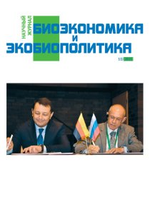Activation of Intein Processing by PNGase F Deglycosylation
Автор: Хлебанов Ф. А.
Рубрика: Тезисы
Опубликовано в Биоэкономика и экобиополитика №1 (1) декабрь 2015 г.
Дата публикации: 30.01.2016
Статья просмотрена: 7 раз
Библиографическое описание:
Хлебанов, Ф. А. Activation of Intein Processing by PNGase F Deglycosylation / Ф. А. Хлебанов. — Текст : непосредственный // Биоэкономика и экобиополитика. — 2015. — № 1 (1). — URL: https://moluch.ru/th/7/archive/20/685/ (дата обращения: 24.04.2024).
Intein known as a "protein introns" have found an important role in biotechnology. Inteins can be applicable as a self-cleaving affinity tag for protein purification. Modified inteins are capable of site-specific cleavage at its N- or C-ends. Intein cleavage is induced by the addition of thiol-containing compounds (N-end) or by shifting pH and temperatures (C-end). Therefore, intein system is an alternative to conventional cleavage of affinity tags by site-specific endoproteases. However, a potential problem associated with the intein system is that spontaneous cleavage can occur at various levels during expression and purification.
Here we present the development of a novel approach of intein processing regulation. It is based on (1) the introduction of artificially N-glycosylated site at conserved aspartate position and (2) subsequent deglycosylation by Peptide -N-Glycosidase F (PNGaseF) that catalyzes the cleavage of the amide bond beetween the proximal N-acetylglucosamine and the asparagine side chain of the polypeptide, resulting in the conversion of the asparagine residue to aspartate.
We performed asparagin scanning mutagenesis of conserved aspartate residues within the intein PRP8 from Penicillium chrysogenum in order to choose a suitable location for N-glycosylation site introduction. Mutation of highly conserved aspartate-150 decelerate in vivo intein processing in E.coli. Also we have shown that mutation of residue that located at position +2 (L152T) does not affect on intein processing in E.coli. Thus, intein with artificial N-glycosylation site (N150, T152) was constructed. This intein was fused with polyhistidine tag and human serum albumin (His10_intein_HSA) and extracellularlly expressed in Saccharomyces cerevisiae. The fusion protein was stably expressed and almost completely glycosylated. We examined the effect of deglycosylation after Ni-NTA based protein purification. Self-cleavage of intein was efficiently induced by deglycosylation, moreover deglycosylation by PNGaseF had a greater impact on intein cleavage than deglycosylation by EndoH due to Asn → Asp converting.
Thus, this approach has the potential to provide strong and swichable control of intein cleavage via its expression in yeast or other hosts having the ability to strong N-glycosylation.







